 | –≠–ª–µ–∫—Ç—Ä–æ–Ω–Ω—ã–π –∫–æ–º–ø–æ–Ω–µ–Ω—Ç: TH71111 | –°–∫–∞—á–∞—Ç—å:  PDF PDF  ZIP ZIP |

TH71111
868/915MHz Receiver
FSK/FM/ASK Receiver
3901071111
Page 1 of 20
Data Sheet
Rev. 007
Feb./03
Features
!
Single superhet architecture for low external component count
!
FSK for digital data and FM reception for analog signal transmission
!
FSK/FM demodulation with phase-coincidence demodulator
!
Low current consumption in active mode and very low standby current
!
Switchable LNA gain for improved dynamic range
!
RSSI allows signal strength indication and ASK detection
!
Surface mount package LQFP32
Ordering Information
Part No.
Temperature Code
Package Code
TH71111
E (-40 ∞C to 85 ∞C)
NE (LQFP32)
Application Examples
!
General digital and analog 868 MHz or
915 MHz ISM band usage
!
Low-power
telemetry
!
Alarm and security systems
!
Remote Keyless Entry (RKE)
!
Tire Pressure Monitoring System (TPMS)
!
Garage door openers
!
Home
automation
!
Pagers
Pin Description
General Description
The TH71111 FSK/FM/ASK single-conversion superheterodyne receiver IC is designed for applications in the
European 868 MHz industrial-scientific-medical (ISM) band, according to the EN 300 220 telecommunications
standard. It can also be used for any other system with carrier frequencies ranging from 800 MHz to 930 MHz
(e.g. for applications in the US 915 MHz ISM band).
V
EE_
L
N
AC
O
U
T
_LN
A
IN
_M
I
X
1
VEE_
M
I
X
I
F
_1P
IF
_
1
N
V
CC_
M
I
X
GA
I
N
_
L
N
A
VC
C
_
BI
AS
VEE_
BI
AS
OA
P
OA
N
OU
T
_
O
A
R
SSI
OU
T
P
VEE_RO
RO
ENRX
VEE_LNA
IN_LNA
VCC_LNA
LF
VCC_PLL
OUT_IFA
FBC1
FBC2
IN_IFA
VEE_IF
OUT_MIX2
VCC_IF
1
32
8
9
24
25
TH71111
17
16

TH71111
868/915MHz Receiver
FSK/FM/ASK Receiver
3901071111
Page 2 of 20
Data Sheet
Rev. 007
Feb./03
Document Content
1
Theory of Operation...................................................................................................3
1.1 General .............................................................................................................................. 3
1.2 Technical Data Overview ................................................................................................... 3
1.3 Block Diagram.................................................................................................................... 4
1.4 Mode Configurations .......................................................................................................... 4
1.5 LNA GAIN Control.............................................................................................................. 4
1.6 Frequency Planning ........................................................................................................... 5
1.6.1
Selected Frequency Plans ............................................................................................................5
2
Pin Definitions and Descriptions ..............................................................................6
3
Technical Data............................................................................................................9
3.1 Absolute Maximum Ratings................................................................................................ 9
3.2 Normal Operating Conditions ............................................................................................. 9
3.3 Crystal Parameters ............................................................................................................ 9
3.4 DC Characteristics ........................................................................................................... 10
3.5 AC System Characteristics .............................................................................................. 11
4
Test Circuits .............................................................................................................12
4.1 FSK Reception................................................................................................................. 12
4.2 FSK test circuit component list (Fig. 2)............................................................................. 13
4.3 FSK/FM Circuit with AFC and Ceramic Resonator Compensation ................................... 14
4.4 FSK/FM (with AFC) test circuit component list (Fig.3)...................................................... 15
4.5 ASK Reception................................................................................................................. 16
4.6 ASK Test Circuit Component List (Fig. 4)......................................................................... 17
5
Package Dimensions ...............................................................................................18
6
Reliability Information .............................................................................................19
7
ESD Precautions ......................................................................................................19
8
Disclaimer.................................................................................................................20
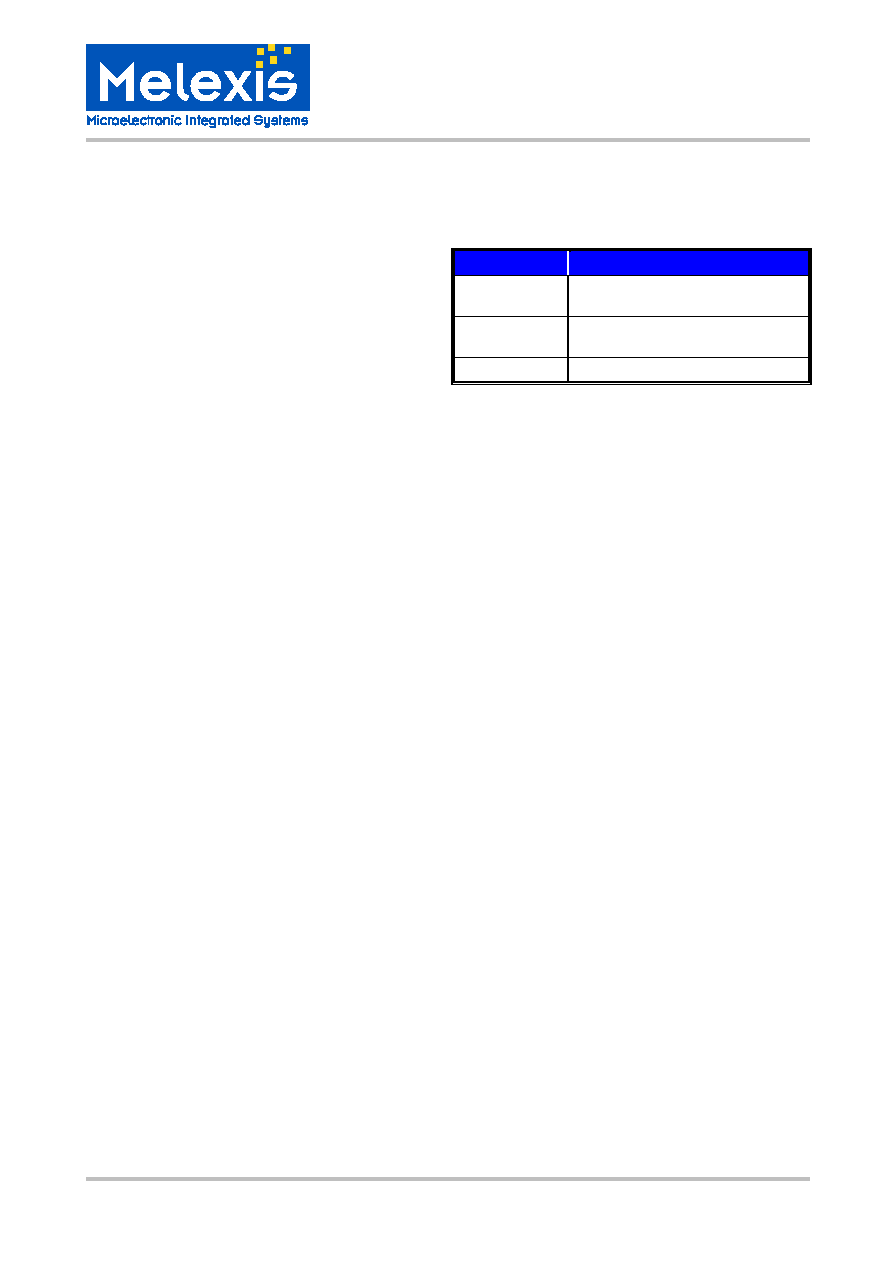
TH71111
868/915MHz Receiver
FSK/FM/ASK Receiver
3901071111
Page 3 of 20
Data Sheet
Rev. 007
Feb./03
1
Theory of Operation
1.1 General
With the TH71111 receiver chip, various circuit con-
figurations can be arranged in order to meet a num-
ber of different customer requirements. For FSK/FM
reception the IF tank used in the phase coincidence
demodulator can be constituted either by a ceramic
resonator or an LC tank (optionally with a varactor
diode to create an AFC circuit). In ASK configura-
tion, the RSSI signal is feed to an ASK detector,
which is constituted by the operational amplifier.
Demodulation
Type of receiver
FSK / FM
narrow-band RX with
ceramic demodulation tank
FSK / FM
wide-band RX with
LC demodulation tank
ASK
RX with RSSI-based demodulation
A double-conversion variant, called TH71112, is also available. This receiver IC allows a higher degree of
image rejection, achieved in conjunction with an RF front-end filter. Both RXICs have the same die. At the
TH71112, the second mixer (MIX2) is used to down-convert the first IF (IF1) to the second IF (IF2). At the
TH71111, MIX2 operates as an amplifier.
Efficient RF front-end filtering is realized by using a SAW, ceramic or helix filter in front of the LNA and by
adding an LC filter at the LNA output.
The TH71111 receiver IC consists of the following building blocks:
"
PLL synthesizer (PLL SYNTH) for generation of the local oscillator signal LO
"
Parts of the PLL SYNTH are the high-frequency VCO1, the feedback divider DIV_32,
a phase-frequency detector (PFD) with charge pump (CP) and a crystal-based reference oscillator (RO)
"
Low-noise amplifier (LNA) for high-sensitivity RF signal reception
"
First mixer (MIX1) for down-conversion of the RF signal to the IF
"
IF pre amplifier which is a mixer cell (MIX2) that operates as an amplifier
"
IF amplifier (IFA) to amplify and limit the IF signal and for RSSI generation
"
Phase coincidence demodulator (DEMOD) with third mixer (MIX3) to demodulate the IF signal
"
Operational amplifier (OA) for data slicing, filtering and ASK detection
"
Bias circuitry for bandgap biasing and circuit shutdown
1.2 Technical Data Overview
!
Input frequency range: 800 MHz to 930 MHz
!
Power supply range: 2.3 V to 5.5 V @ ASK
!
Temperature range: -40 ∞C to +85 ∞C
!
Standby current: 50 nA
!
Operating current: 7.5 mA at low gain mode
9.2 mA at high gain mode
!
Sensitivity: -112 dBm
1)
with 40 kHz IF filter BW
!
Sensitivity: -105 dBm
2)
with 150 kHz IF filter BW
!
Range of IF: 400 kHz to 22 MHz
!
Maximum data rate: 80 kbit/s NRZ
!
Maximum input level: -10 dBm at ASK
0 dBm at FSK
!
Image rejection: > 55 dB (e.g. with SAW
front-end filter and at 10.7 MHz IF)
!
Spurious emission: < -70 dBm
!
Input frequency acceptance:
±
50 kHz
(with AFC option)
!
RSSI range: 70 dB
!
Frequency deviation range:
±
4 kHz to
±
120 kHz
!
Maximum analog modulation frequency: 15 kHz
1) at
±
8 kHz FSK deviation, BER = 3
10
-3
and phase-coincidence demodulation
2) at
±
50 kHz FSK deviation, BER = 3
10
-3
and phase-coincidence demodulation
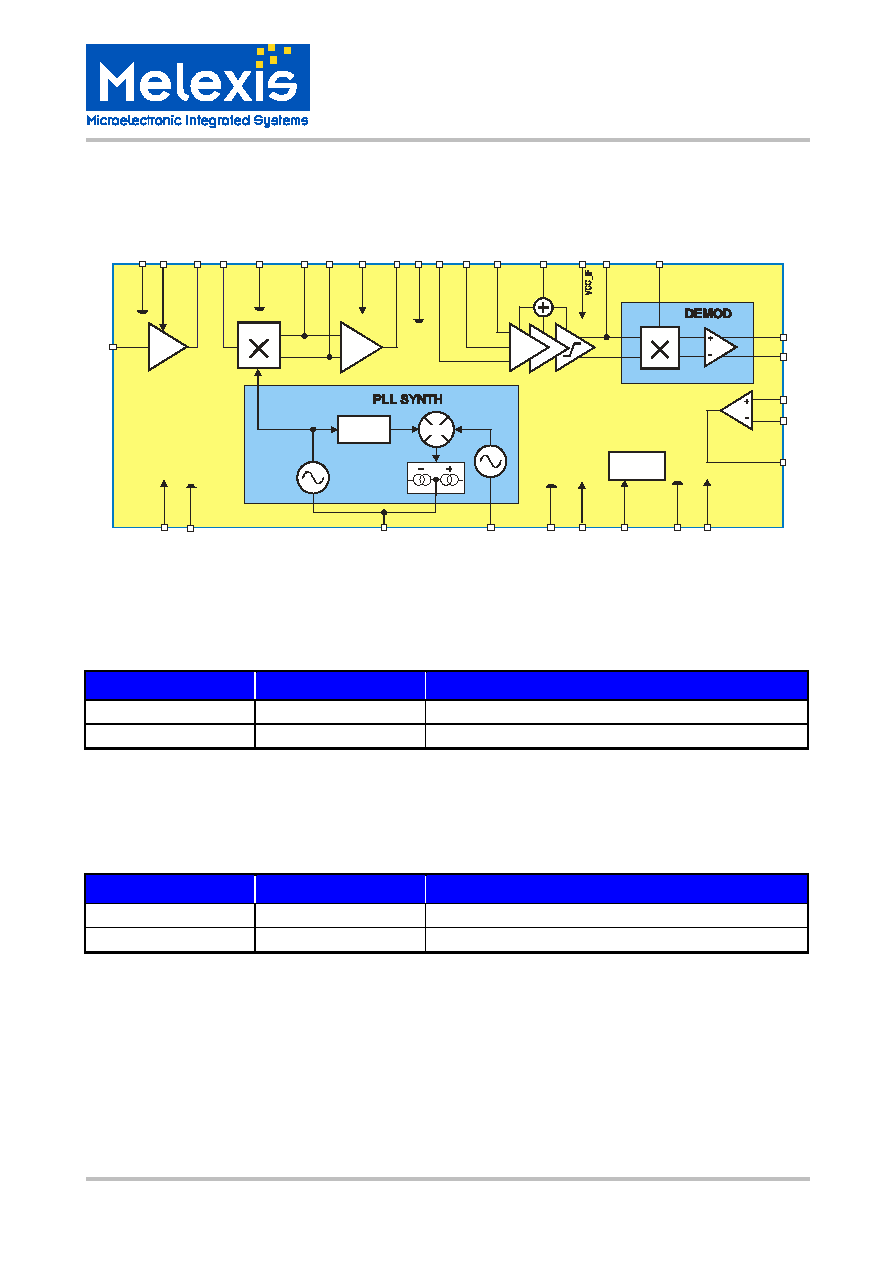
TH71111
868/915MHz Receiver
FSK/FM/ASK Receiver
3901071111
Page 4 of 20
Data Sheet
Rev. 007
Feb./03
1.3 Block
Diagram
Fig. 1:
TH71111 block diagram
1.4 Mode
Configurations
ENRX
Mode
Description
0
RX standby
RX disabled
1
RX active
RX enable
Note: ENRX are pulled down internally
1.5 LNA GAIN Control
V
GAIN_LNA
Mode
Description
< 0.8 V
HIGH GAIN
LNA set to high gain
> 1.4 V
LOW GAIN
LNA set to low gain
Note: hysteresis between gain modes to ensure stability
IN_LNA
LNA
MIX1
IFA
GA
I
N
_
L
N
A
O
U
T_
LN
A
FP
C
2
R
SSI
OU
T
_
I
F
A
IN
_
D
E
M
OUTP
OUTN
MIX3
21
9
3
2
31
1
VEE_
L
N
A
C
5
VEE_
MI
X
32
V
CC_
L
N
A
30
VEE_
L
N
A
IN
_
M
I
X
1
4
V
CC_M
I
X
8
13
15
16
LO
RO
LF
26
VCO1
CP
DIV_32
RO
PFD
29
24
23
VC
C
_
PL
L
27
BIAS
28
EN
R
X
17
VC
C
_
B
I
A
S
22
VEE_
B
I
A
S
25
VEE_
R
O
14
IF
OU
T
_
M
I
X
2
IN
_
I
F
A
11
VEE_
I
F
10
FB
C
1
12
OAP
OAN
19
20
18
OUT_OA
OA
IF
IF1
P
IF
1
N
7
6
MIX2

TH71111
868/915MHz Receiver
FSK/FM/ASK Receiver
3901071111
Page 5 of 20
Data Sheet
Rev. 007
Feb./03
1.6 Frequency
Planning
Frequency planning is straightforward for single-conversion applications because there is only one IF that
might be chosen, and then the only possible choice is low-side or high-side injection of the LO signal (which
is now the one and only LO signal in the receiver).
The receiver's single-conversion architecture requires careful frequency planning. Besides the desired RF
input signal, there are a number of spurious signals that may cause an undesired response at the output.
Among them is the image of the RF signal that must be suppressed by the RF front-end filter.
By using the internal PLL synthesizer of the TH71111 with the fixed feedback divider ratio of N = 32 (DIV_32),
two types of down-conversion are possible: low-side injection of LO and high-side injection of LO. The fol-
lowing table summarizes some equations that are useful to calculate the crystal reference frequency (REF),
the IF and the LO frequency respectively, for a given RF.
Injection type
low
high
REF
(RF ≠ IF)/32
(RF + IF)/32
LO
32
∑
REF
32
∑
REF
IF
RF ≠ LO
LO ≠ RF
RF image
RF ≠ 2IF
RF + 2IF
1.6.1 Selected Frequency Plans
The following table depicts crystal, LO and image signals considering the examples of 868.3 MHz and
915 MHz RF reception at IF = 10.7 MHz.
Signal type
RF = 868.3 MHz
RF = 868.3 MHz
RF = 915 MHz
RF = 915 MHz
Injection type
low
high
low
high
REF / MHz
26.80000
27.46875
28.25938
28.92813
LO / MHz
857.6
879.0
904.3
925.7
RF image / MHz
846.9
889.7
893.6
936.4
The selection of the reference crystal frequency is based on some assumptions. As for example: the image
frequency should not be in a radio band where strong interfering signals might occur (because they could
represent parasitic receiving signals), the LO signal should be in the range of 800 MHz to 930 MHz (because
this is the optimum frequency range of the VCO1). Furthermore the IF should be as high as possible to
achieve highest RF image rejection. The columns in bold depict the selected frequency plans to receive at
868.3 MHz and 915 MHz, respectively.
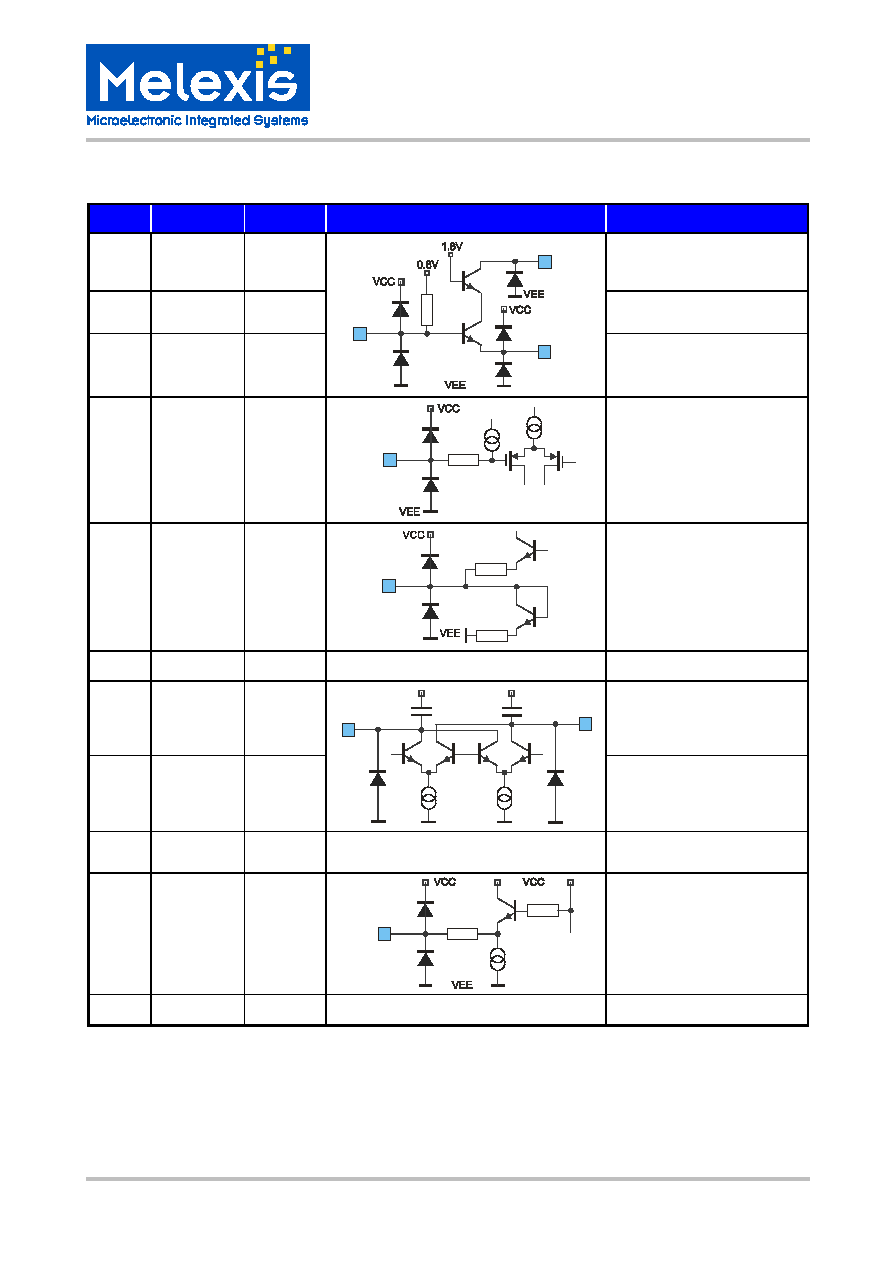
TH71111
868/915MHz Receiver
FSK/FM/ASK Receiver
3901071111
Page 6 of 20
Data Sheet
Rev. 007
Feb./03
2
Pin Definitions and Descriptions
Pin No.
Name
I/O Type
Functional Schematic
Description
3
OUT_LNA
analog
output
LNA open-collector output,
to be connected to external
LC tank that resonates at RF
31
IN_LNA
analog
input
LNA input, approx.
26
single-ended
1
VEE_LNAC ground
OUT_LNA
3
5k
VEE_LNAC
1
IN_LNA
31
ground of LNA core
(cascode)
2
GAIN_LNA
analog
input
GAIN_LNA
2
400
LNA gain control
(input with hysteresis)
RX standby: no pull-up
RX active: pull-up
4
IN_MIX1
analog
input
IN_MIX1
4
500µA
13
13
MIX1 input, approx. 33
single-ended
5
VEE_MIX
ground
ground of MIX1 and MIX2
6
IF1P
analog I/O
open-collector output, to be
connected to external LC
tank that resonates at first IF
7
IF1N
analog I/O
20p
20p
2x500µA
IF1P
6
VEE
VCC
VEE
IF1N
7
open-collector output, to be
connected to external LC
tank that resonates at first IF
8
VCC_MIX
supply
positive supply of
MIX1 and MIX2
9
OUT_MIX2
analog
output
130
6.8k
OUT_MIX2
9
230µA
MIX2 output, approx. 330
output impedance
10
VEE_IF
ground
ground of IFA and DEMOD
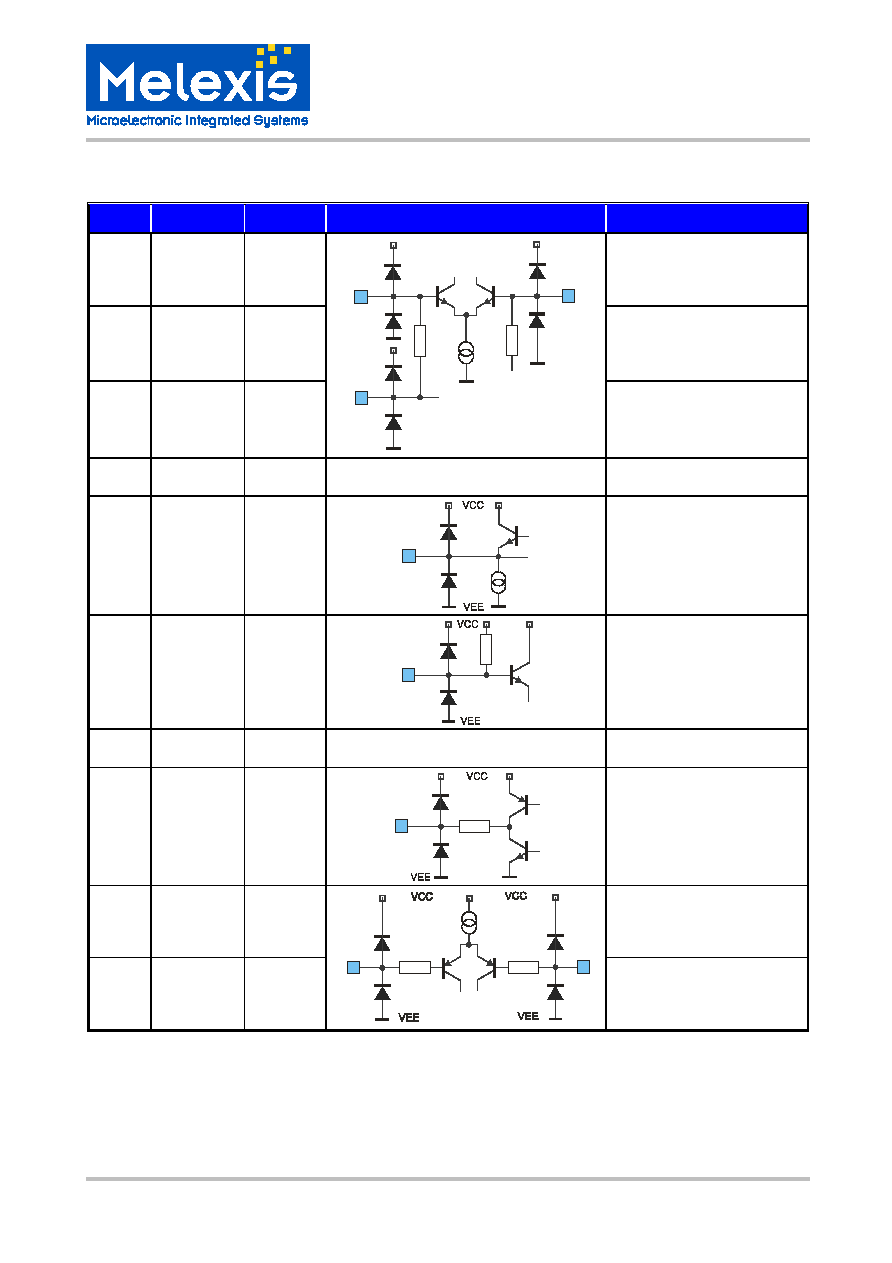
TH71111
868/915MHz Receiver
FSK/FM/ASK Receiver
3901071111
Page 7 of 20
Data Sheet
Rev. 007
Feb./03
Pin No.
Name
I/O Type
Functional Schematic
Description
11
IN_IFA
analog
input
IFA input, approx. 2.2k
input impedance
12
FBC1
analog I/O
to be connected to external
IFA feedback capacitor
13
FBC2
analog I/O
2.2k
2.2k
200µA
IN_IFA
11
VEE
VEE
VCC
VEE
VCC
12
FBC1
FBC2
13
VEE
VCC
to be connected to external
IFA feedback capacitor
14
VCC_IF
supply
positive supply of
IFA and DEMOD
15
OUT_IFA
analog I/O
OUT_IFA
15
40µA
IFA output and MIX3 input
(of DEMOD)
16
IN_DEM
analog
input
IN_DEM
16
47k
DEMOD input, to MIX3 core
17
VCC_BIAS
supply
positive supply of general
bias system and OA
18
OUT_OA
analog
output
OUT_OA
18
50
OA output, 40uA current
drive capability
19
OAN
analog
input
negative OA input
20
OAP
analog
input
20µA
19
OAN
50
20
OAP
50
positive OA input

TH71111
868/915MHz Receiver
FSK/FM/ASK Receiver
3901071111
Page 8 of 20
Data Sheet
Rev. 007
Feb./03
Pin No.
Name
I/O Type
Functional Schematic
Description
21
RSSI
analog
output
I (Pi)
RSSI
21
50
36k
RSSI output, for RSSI and
ASK detection, approx.
36k
output impedance
22
VEE_BIAS
ground
ground of general
bias system and OA
23
OUTP
analog
output
FSK/FM positive output,
output impedance of
100k
to 300k
24
OUTN
analog
output
OUTP
OUTN
23
24
50
20µA
20µA
FSK/FM negative output,
output impedance of
100k
to 300k
25
VEE_RO
ground
ground of DIV, PFD, RO
and charge pump
26
RO
analog
input
RO
26
30p
30p
50k
RO input, Colpitts type
oscillator with internal feed-
back capacitors
27
VCC_PLL
supply
positive supply of DIV, PFD,
RO and charge pump
28
ENRX
digital
input
ENRX
28
1.5k
mode control input,
CMOS-compatible with
internal pull-down circuit
29
LF
analog I/O
LF
29
200
400
4p
charge pump output and
VCO1 control input
30
VEE_LNA
ground
ground of LNA biasing
32
VCC_LNA
supply
positive supply of
LNA biasing

TH71111
868/915MHz Receiver
FSK/FM/ASK Receiver
3901071111
Page 9 of 20
Data Sheet
Rev. 007
Feb./03
3
Technical Data
3.1 Absolute Maximum Ratings
Parameter
Symbol
Condition / Note
Min
Max
Unit
Supply voltage
V
CC
0
7.0
V
Input voltage
V
IN
- 0.3
V
cc
+0.3
V
Input RF level
P
iRF
@ LNA input
10
dBm
Storage temperature
T
STG
-40
+125
∞C
Junction temperature
T
J
+150
∞C
Thermal Resistance
R
thJA
60
K/W
Power dissipation
P
diss
0.1
W
V
ESD1
human body model, 1)
-1.0
+1.0
Electrostatic discharge
V
ESD2
human body model, 2)
-0.75
+0.75
kV
1) all pins except OUT_LNA, IF1P and IF1N
2) pin OUT_LNA, IF1P and IF1N
3.2 Normal Operating Conditions
Parameter
Symbol
Condition
Min
Max
Unit
0 ∞C to 85 ∞C
2.5
5.5
-20 ∞C to 85 ∞C
2.6
5.5
V
CC, FSK
-40 ∞C to 85 ∞C
2.7
5.5
Supply voltage
V
CC, ASK
-40 ∞C to 85 ∞C
2.3
5.5
V
Operating temperature
T
A
-40
+85
∫C
Input low voltage (CMOS)
V
IL
ENRX pin
0.3*V
CC
V
Input high voltage (CMOS)
V
IH
ENRX pin
0.7*V
CC
V
Input frequency range
f
i
800
930
MHz
IF range
f
IF
0.4
22
MHz
XOSC frequency
f
ref
set by the crystal
25
29.063
MHz
VCO frequency
f
LO
f
LO
= 32
∑
f
ref
800
930
MHz
Frequency deviation
f
at FSK or FM
±
4
±
120
kHz
FSK data rate
R
FSK
NRZ
40
kbit/s
ASK data rate
R
ASK
NRZ
80
kbit/s
FM bandwidth
f
m
15
kHz
3.3 Crystal
Parameters
Parameter
Symbol
Condition
Min
Max
Unit
Crystal frequency
f
0
fundamental mode, AT
See para. 1.6.1
MHz
Load capacitance
C
L
10
15
pF
Static capacitance
C
0
7
pF
Series resistance
R
1
50

TH71111
868/915MHz Receiver
FSK/FM/ASK Receiver
3901071111
Page 10 of 20
Data Sheet
Rev. 007
Feb./03
3.4 DC
Characteristics
all parameters under normal operating conditions, unless otherwise stated;
typical values at T
A
= 23 ∞C and V
CC
= 3 V
Parameter
Symbol
Condition
Min
Typ
Max
Unit
Operating Currents
Standby current
I
SBY
ENRX=0
50
100
nA
Supply current at low gain
I
CC, low
ENRX=1
GAIN_LNA=1
4.5
7.5
12.0
mA
Supply current at high gain
I
CC, high
ENRX=1
GAIN_LNA=0
5.0
9.2
14.0
mA
Digital Pin Characteristics
Input low voltage CMOS
V
IL
ENRX pin
-0.3
0.3*V
cc
V
Input high voltage CMOS
V
IH
ENRX pin
0.7*V
CC
V
CC
+0.3
V
Pull down current
ENRX pin
I
PDEN
ENRX=1
0.1
2
10
µA
Low level input current
ENRX pin
I
INLEN
ENRX=0
0.05
µA
Analog Pin Characteristics
High level input current
GAIN_LNA pin
I
INHGAIN
GAIN_LNA=1
0.05
µA
Pull up current
GAIN_LNA pin active
I
PUGAINa
GAIN_LNA=0
ENRX=1
0.08
0.15
0.3
µA
Pull up current
GAIN_LNA pin standby
I
PUGAINs
GAIN_LNA=0
ENRX=0
0.05
µA
High gain input voltage
V
IHGAIN
ENRX=1
0.7
V
Low gain input voltage
V
ILGAIN
ENRX=1
1.5
V
Opamp Characteristics
Opamp input offset voltage
V
offs
-35
35
mV
Opamp input offset current
I
offs
I
OAP
≠ I
OAN
-50
50
nA
Opamp input bias current
I
bias
0.5 * (I
OAP
+ I
OAN
)
-150
150
nA
RSSI Characteristics
RSSI voltage at low input level
V
RSSI, low
P
i
= -65 dBm,
GAIN_LNA=1
0.5
1.0
1.5
V
RSSI voltage at high input level
V
RSSI, high
P
i
= -35 dBm,
GAIN_LNA=1
1.2
1.9
2.5
V

TH71111
868/915MHz Receiver
FSK/FM/ASK Receiver
3901071111
Page 11 of 20
Data Sheet
Rev. 007
Feb./03
3.5 AC System Characteristics
all parameters under normal operating conditions, unless otherwise stated;
typical values at T
A
= 23 ∞C and V
CC
= 3 V,
RF at 868.3 MHz; SAW frond-end filter loss and IF at 10.7 MHz;
all parameters based on test circuits for FSK (Fig. 2) and ASK (Fig. 4), respectively;
Parameter
Symbol
Condition
Min
Typ
Max
Unit
Receive Characteristics
Input sensitivity ≠ FSK
(narrow band)
P
min, n
B
IF
= 40kHz
f =
±
15kHz (FSK/FM)
BER
3
10
-3
, 1)
-109
dBm
Input sensitivity ≠ FSK
(wide band)
P
min, w
B
IF
= 150kHz
f =
±
50kHz (FSK/FM)
BER
3
10
-3
, 1)
-102
dBm
Input sensitivity ≠ ASK
(narrow band)
P
minA, n
B
IF
= 40kHz
BER
3
10
-3
, 1)
-108
dBm
Input sensitivity ≠ ASK
(wide band)
P
minA, w
B
IF
= 150kHz
BER
3
10
-3
, 1)
-104
dBm
Maximum input signal ≠ FSK/FM
P
max, FSK
BER
3
10
-3
GAIN_LNA=1
0
dBm
Maximum input signal ≠ ASK
P
max, ASK
BER
3
10
-3
GAIN_LNA=1
-10
dBm
Spurious emission
P
spur
-70
dBm
Image rejection
P
imag
55
dB
Blocking immunity
P
block
f
block
>
±
2MHz, 2)
57
dB
Start-up Parameters
Start-up time ≠ FSK/FM
T
FSK
ENRX from 0 to 1,
valid data at output
0.9
ms
Start-up time ≠ ASK
T
ASK
depends on ASK
detector time constant,
valid data at output
R3
∑
C12
+
T
FSK
ms
PLL Parameters
VCO gain
K
VCO
350
MHz/V
Charge pump current
I
CP
60
µA
1) inclusive 3 dB loss of front-end SAW filter
2) desired signal with FSK/FM or ASK modulation, CW blocking signal

TH71111
868/915MHz Receiver
FSK/FM/ASK Receiver
3901071111
Page 12 of 20
Data Sheet
Rev. 007
Feb./03
4
Test Circuits
4.1 FSK
Reception
Fig. 2:
Test circuit for FSK reception
G
A
IN
_LN
A
OU
T
_
L
N
A
OUT_MIX2
VEE
FBC1
IN_IFA
FBC2
VCC
OUT_IFA
IN_DEM
VC
C
OU
T_O
A
OA
N
OA
P
RSS
I
VE
E
OU
T
P
OUT
N
VCC
VCC
RO
VEE
VCC
VE
E
IN
_M
IX1
VE
E
IF
1N
IF
1P
VC
C
ENRX
LF
VEE
VCC
IN_LNA
LQFP32
C12
CP
C13
CERRES
C11
C7
C6
R1
C3
C1
XTAL
L3
VCC
SA
W
F
IL
C4
L1
L2
C5
C10
C9
CERFIL
VCC
VCC
C14
C16
C15
RL2
RL1
CB*

TH71111
868/915MHz Receiver
FSK/FM/ASK Receiver
3901071111
Page 13 of 20
Data Sheet
Rev. 007
Feb./03
4.2 FSK test circuit component list (Fig. 2)
Part
Size
Value / Type
Tolerance
Description
C1
0805
15 pF
±
10%
crystal series capacitor
C3
0805
1 nF
±
10%
loop filter capacitor
C4
0603
4.7 pF
±
5%
capacitor to match to SAW filter input
C5
0603
2.7 pF
±
5%
capacitor to match to SAW filter output
C6
0603
NIP
±
5%
LNA output tank capacitor
C7
0603
1.2 pF
±
5%
MIX1 input matching capacitor
C9
0805
33 nF
±
10%
IFA feedback capacitor
C10
0603
1 nF
±
10%
IFA feedback capacitor
C11
0603
1 nF
±
10%
IFA feedback capacitor
C12
0603
1.5 pF
±
5%
DEMOD phase-shift capacitor
C13
0603
680 pF
±
10%
DEMOD coupling capacitor
CP
0805
10 ≠ 12 pF
±
5%
CERRES parallel capacitor
C14
0805
10 ≠ 47 pF
±
5%
demodulator output low-pass capacitor, depending on
data rate
C15
0805
10 ≠ 47 pF
±
5%
demodulator output low-pass capacitor, depending on
data rate
C16
0603
1.5 nF
±
10%
RSSI output low-pass capacitor
R1
0805
10 k
±
10%
loop filter resistor
RL1
0805
470
±
5%
MIX1 bias resistor
RL2
0805
470
±
5%
MIX1 bias resistor
L1
0603
12 nH
±
5%
inductor to match SAW filter
L2
0603
12 nH
±
5%
inductor to match SAW filter
L3
0603
6.8 nH
±
5%
LNA output tank inductor
XTAL
HC49
SMD
26.80000 MHz
@ RF = 868.3 MHz
±
25ppm calibration
±
30ppm temp.
fundamental-mode crystal, C
load
= 10 pF to 15pF,
C
0, max
= 7 pF, R
m, max
= 50
SAWFIL
QCC8C
B3570
@ RF = 868.3 MHz
B
3dB
= 1.7MHz
low-loss SAW filter from EPCOS
Leaded
type
SFE10.7MFP
@ B
IF2
= 40 kHz
TBD
CERFIL
SMD type
SFECV10.7MJS-A
@ B
IF2
= 150 kHz
±
40 kHz
ceramic filter from Murata
CERRES SMD type
CDACV10.7MG18-A
ceramic demodulator tank from Murata

TH71111
868/915MHz Receiver
FSK/FM/ASK Receiver
3901071111
Page 14 of 20
Data Sheet
Rev. 007
Feb./03
4.3 FSK/FM Circuit with AFC and Ceramic Resonator Compensation
Fig. 3:
Test circuit for FSK/FM with AFC and resonator compensation
Circuit Features
!
Improves input frequency acceptance range up to RF
nom
±
50 kHz
!
Eliminates calibration tolerances of ceramic resonator
!
Eliminates temperature tolerances of ceramic resonator
!
Non-inverted and inverted CMOS-compatible outputs
!
Recommended FM receiver configuration
CP VD
C17
C18
R4
R5
R3
G
A
IN
_LN
A
O
U
T
_LN
A
OUT_MIX2
VEE
FBC1
IN_IFA
FBC2
VCC
OUT_IFA
IN_DEM
VC
C
OU
T_O
A
OAN
OAP
RS
SI
VE
E
OU
TP
OU
TN
VCC
VCC
RO
VEE
VCC
VE
E
IN
_
M
I
X
1
VE
E
IF
1
N
IF
1
P
VCC
ENRX
LF
VEE
VCC
IN_LNA
LQFP32
C12
C13
CERRES
C11
C7
C6
R1
C3
C1
XTAL
L3
VCC
SA
W
F
IL
C4
L1
L2
C5
C10
C9
CERFIL
VCC
VCC
C14
C16
C15
RL2
RL1
CB*

TH71111
868/915MHz Receiver
FSK/FM/ASK Receiver
3901071111
Page 15 of 20
Data Sheet
Rev. 007
Feb./03
4.4 FSK/FM (with AFC) test circuit component list (Fig.3)
Part
Size
Value / Type
Tolerance
Description
C1
0805
15 pF
±
10%
crystal series capacitor
C3
0805
1 nF
±
10%
loop filter capacitor
C4
0603
4.7 pF
±
5%
capacitor to match to SAW filter input
C5
0603
2.7 pF
±
5%
capacitor to match to SAW filter output
C6
0603
NIP
±
5%
LNA output tank capacitor
C7
0603
1.2 pF
±
5%
MIX1 input matching capacitor
C9
0805
33 nF
±
10%
IFA feedback capacitor
C10
0603
1 nF
±
10%
IFA feedback capacitor
C11
0603
1 nF
±
10%
IFA feedback capacitor
C12
0603
1.5 pF
±
5%
DEMOD phase-shift capacitor
C13
0603
680 pF
±
10%
DEMOD coupling capacitor
CP
0805
10 ≠ 12 pF
±
5%
ceramic resonator loading capacitor
C14
0805
10 ≠ 47 pF
±
5%
demodulator output low-pass capacitor, depending on
data rate
C15
0805
10 ≠ 47 pF
±
5%
demodulator output low-pass capacitor, depending on
data rate
C16
0603
1.5 nF
±
10%
RSSI output low-pass capacitor
C17
33 nF
±
10%
integrator capacitor, fixed
33 nF
integrator capacitor, @ 0.5 to 2 kbit/s NRZ
10 nF
integrator capacitor, @ 2 to 20 kbit/s NRZ
C18
0805
1 nF
±
10%
integrator capacitor, @ 20 to 40 kbit/s NRZ
R1
0805
10 k
±
10%
loop filter resistor
R3
0805
100 k
±
10%
varactor diode biasing resistor
R4
0805
680 k
±
10%
integrator resistor
R5
0805
680 k
±
10%
integrator resistor
RL1
0805
470
±
5%
MIX1 bias resistor
RL2
0805
470
±
5%
MIX1 bias resistor
L1
0603
12 nH
±
5%
inductor to match SAW filter
L2
0603
12 nH
±
5%
inductor to match SAW filter
L3
0603
6.8 nH
±
5%
LNA output tank inductor
VD
SOD-323
BB535
varactor diode from Infineon
XTAL
HC49
SMD
26.80000 MHz
@ RF = 868.3 MHz
±
25ppm calibration
±
30ppm temp.
fundamental-mode crystal, C
load
= 10 pF to 15pF,
C
0, max
= 7 pF, R
m, max
= 50
SAWFIL
QCC8C
B3570
@ RF = 868.3 MHz
B
3dB
= 1.7MHz
low-loss SAW filter from EPCOS
Leaded
type
SFE10.7MFP
@ B
IF2
= 40 kHz
TBD
CERFIL
SMD type
SFECV10.7MJS-A
@ B
IF2
= 150 kHz
±
40 kHz
ceramic filter from Murata
CERRES SMD type
CDACV10.7MG18-A
ceramic demodulator tank from Murata
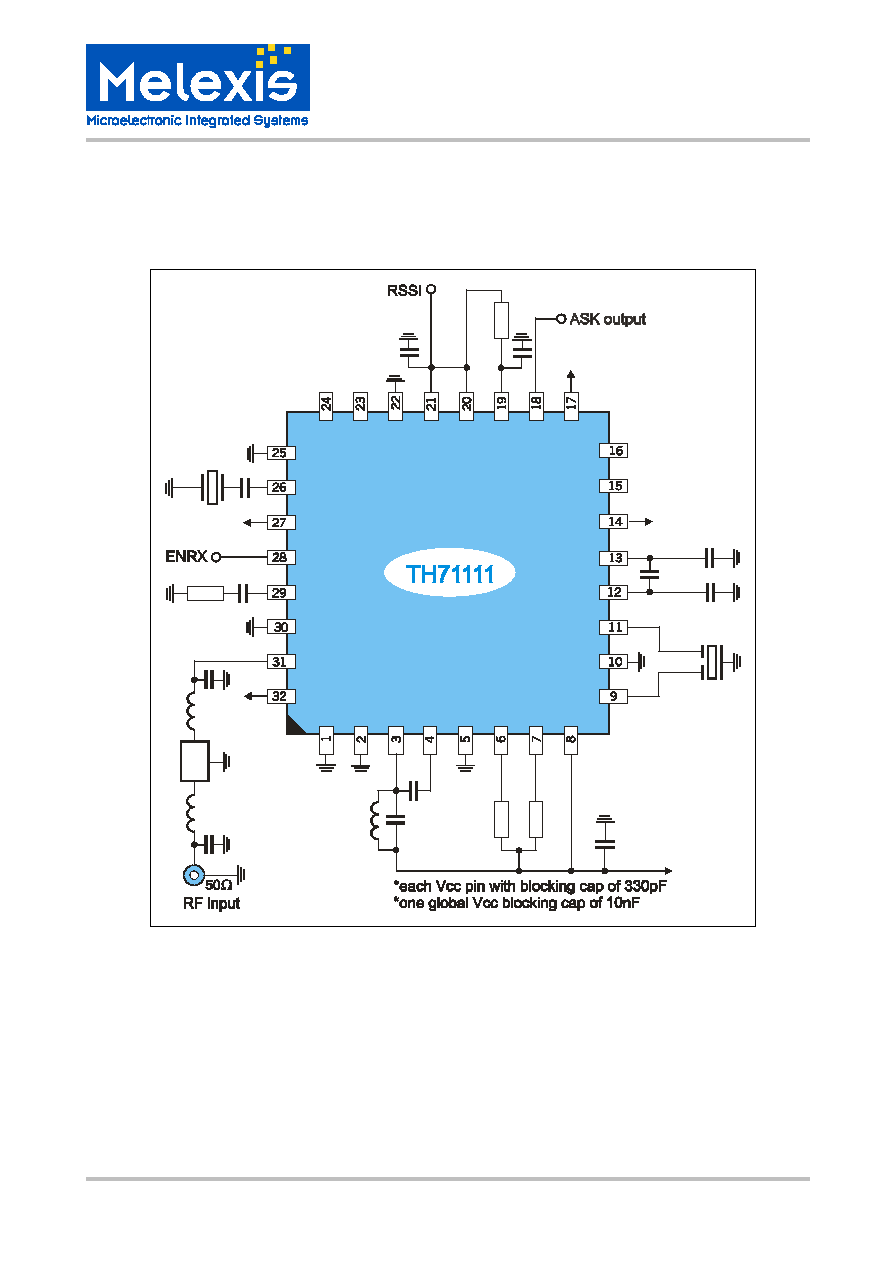
TH71111
868/915MHz Receiver
FSK/FM/ASK Receiver
3901071111
Page 16 of 20
Data Sheet
Rev. 007
Feb./03
4.5 ASK
Reception
Fig. 4:
Test circuit for ASK reception
C12
VCC
R3
C13
G
A
IN
_LN
A
OU
T
_
L
N
A
OUT_MIX2
VEE
FBC1
IN_IFA
FBC2
VCC
OUT_IFA
IN_DEM
VCC
OU
T_O
A
OA
N
OA
P
RS
SI
VEE
OU
TP
OU
TN
VCC
VCC
RO
VEE
VCC
VE
E
IN
_M
IX1
VE
E
IF
1N
IF
1P
VC
C
ENRX
LF
VEE
VCC
IN_LNA
LQFP32
C7
C6
R1
C3
C1
XTAL
L3
VCC
SA
W
F
IL
C4
L1
L2
C5
C11
C10
C9
CERFIL
RL1
RL2
CB*
VCC

TH71111
868/915MHz Receiver
FSK/FM/ASK Receiver
3901071111
Page 17 of 20
Data Sheet
Rev. 007
Feb./03
4.6 ASK Test Circuit Component List (Fig. 4)
Part
Size
Value / Type
Tolerance
Description
C1
0805
15 pF
±
10%
crystal series capacitor
C3
0805
1 nF
±
10%
loop filter capacitor
C4
0603
4.7 pF
±
5%
capacitor to match to SAW filter input
C5
0603
2.7 pF
±
5%
capacitor to match to SAW filter output
C6
0603
NIP
±
5%
LNA output tank capacitor
C7
0603
1.2 pF
±
5%
MIX1 input matching capacitor
C9
0805
33 nF
±
10%
IFA feedback capacitor
C10
0603
1 nF
±
10%
IFA feedback capacitor
C11
0603
1 nF
±
10%
IFA feedback capacitor
C12
0805
1 nF to 100 nF
±
10%
ASK data slicer capacitor, depending on data rate
C13
0603
1.5 nF
±
10%
RSSI output low-pass capacitor
R1
0805
10 k
±
10%
loop filter resistor
R3
0603
100 k
±
5%
ASK data slicer resistor, depending on data rate
RL1
0805
470
±
5%
MIX1 bias resistor
RL2
0805
470
±
5%
MIX1 bias resistor
L1
0603
12 nH
±
5%
inductor to match SAW filter
L2
0603
12 nH
±
5%
inductor to match SAW filter
L3
0603
6.8 nH
±
5%
LNA output tank inductor
XTAL
HC49
SMD
26.80000 MHz
@ RF = 868.3 MHz
±
25ppm calibration
±
30ppm temp.
fundamental-mode crystal, C
load
= 10 pF to 15pF,
C
0, max
= 7 pF, R
m, max
= 50
SAWFIL
QCC8C
B3570
@ RF = 868.3 MHz
B
3dB
= 1.7MHz
low-loss SAW filter from EPCOS
leaded
type
SFE10.7MFP @
B
IF2
= 40 kHz
TBD
CERFIL
SMD type
SFECV10.7MJS-A
@ B
IF2
= 150 kHz
±
40 kHz
ceramic filter from Murata
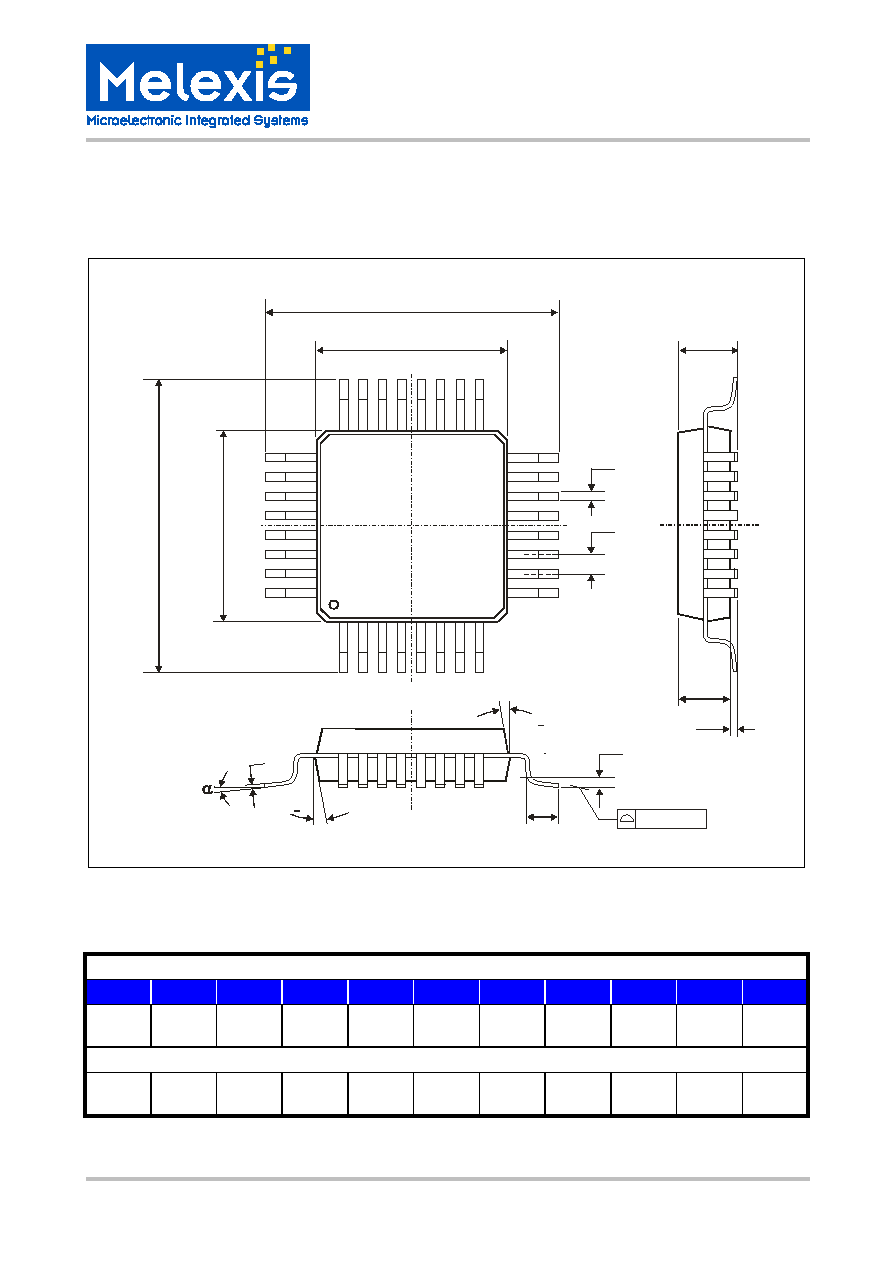
TH71111
868/915MHz Receiver
FSK/FM/ASK Receiver
3901071111
Page 18 of 20
Data Sheet
Rev. 007
Feb./03
5
Package Dimensions
Fig. 5:
LQFP32 (Low profile Quad Flat Package)
All Dimension in mm, coplanarÌty < 0.1mm
E1, D1
E, D
A
A1
A2
e
b
c
L
min
1.40
0.05
1.35
0.30
0.09
0.45
0∞
max
7.00
9.00
1.60
0.15
1.45
0.8
0.45
0.20
0.75
7∞
All Dimension in inch, coplanarÌty < 0.004"
min
0.055
0.002
0.053
0.012
0.0035
0.018
0∞
max
0.276
0.354
0.063
0.006
0.057
0.031
0.018
0.0079
0.030
7∞
1
32
25
17
24
8
9
16
D
D1
E1
e
b
E
A2
A
A1
L
c
0.25
(0.0098)
12∞
1∞
+
12∞
1∞
+
.10 (.004)

TH71111
868/915MHz Receiver
FSK/FM/ASK Receiver
3901071111
Page 19 of 20
Data Sheet
Rev. 007
Feb./03
6
Reliability Information
Melexis devices are classified and qualified regarding suitability for infrared, vapor phase and wave soldering
with usual (63/37 SnPb-) solder (melting point at 183degC).
The following test methods are applied:
∑
IPC/JEDEC J-STD-020A (issue April 1999)
Moisture/Reflow Sensitivity Classification For Nonhermetic Solid State Surface Mount Devices
∑
CECC00802 (issue 1994)
Standard Method For The Specification of Surface Mounting Components (SMDs) of Assessed Quality
∑
MIL 883 Method 2003 / JEDEC-STD-22 Test Method B102
Solderability
For all soldering technologies deviating from above mentioned standard conditions (regarding peak tem-
perature, temperature gradient, temperature profile etc) additional classification and qualification tests have to
be agreed upon with Melexis.
The application of Wave Soldering for SMD's is allowed only after consulting Melexis regarding assurance of
adhesive strength between device and board.
For more information on manufacturability/solderability see quality page at our website:
http://www.melexis.com/
7
ESD Precautions
Electronic semiconductor products are sensitive to Electro Static Discharge (ESD).
Always observe Electro Static Discharge control procedures whenever handling semiconductor products.

TH71111
868/915MHz Receiver
FSK/FM/ASK Receiver
3901071111
Page 20 of 20
Data Sheet
Rev. 007
Feb./03
8
Disclaimer
Devices sold by Melexis are covered by the warranty and patent indemnification provisions appearing in its
Term of Sale. Melexis makes no warranty, express, statutory, implied, or by description regarding the infor-
mation set forth herein or regarding the freedom of the described devices from patent infringement. Melexis
reserves the right to change specifications and prices at any time and without notice. Therefore, prior to de-
signing this product into a system, it is necessary to check with Melexis for current information. This product
is intended for use in normal commercial applications. Applications requiring extended temperature range,
unusual environmental requirements, or high reliability applications, such as military, medical life-support or
life-sustaining equipment are specifically not recommended without additional processing by Melexis for each
application.
The information furnished by Melexis is believed to be correct and accurate. However, Melexis shall not be
liable to recipient or any third party for any damages, including but not limited to personal injury, property
damage, loss of profits, loss of use, interrupt of business or indirect, special incidental or consequential dam-
ages, of any kind, in connection with or arising out of the furnishing, performance or use of the technical data
herein. No obligation or liability to recipient or any third party shall arise or flow out of Melexis' rendering of
technical or other services.
© 2002 Melexis NV. All rights reserved.
For the latest version of this document. Go to our website at
www.melexis.com
Or for additional information contact Melexis Direct:
Europe and Japan:
All other locations:
Phone: +32 1367 0495
Phone: +1 603 223 2362
E-mail: sales_europe@melexis.com
E-mail: sales_usa@melexis.com
QS9000, VDA6.1 and ISO14001 Certified



















